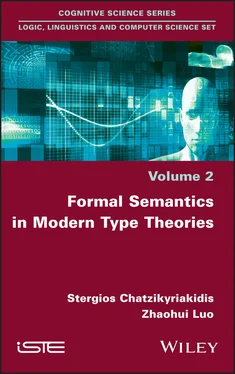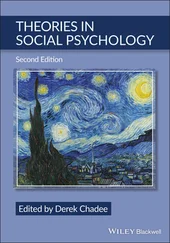Simple examples in Montague semantics can be found in Table 1.1, briefly showing how to interpret some of the basic linguistic categories in the Montagovian setting, including common nouns (CN), verbs (IV), adjectives (ADJ), verb-modifying adverbs (ADV VP), modified CNs, quantifiers and sentences (S). In the following section, we can find Table 1.3 with examples for these categories interpreted in MTT-semantics. For example, in Montague semantics, verb phrases are interpreted as predicates of type e→ tand sentences as formulas of type t, as ( 1.5) and ( 1.6) illustrate (see, the lines for IV and S in Table 1.1):
( 1.5) talk : e→ t
( 1.6) ∃ x : e. man ( x ) ∧ talk ( x )
A remark we should make is that, in type theories, typing judgments and logical formulas are different. In particular, a typing judgment is not a logical formula: ( 1.5) is a typing judgment stating that talk is of type e→ t, while ( 1.6) is a logical formula of type t. With such examples, the difference seems to be apparent and there is no need to be emphasized. However, this becomes more important in the setting of modern type theories where much richer typing mechanisms are employed (see, for example, Chapter 2).
A notational convention is adopted in this book: we shall use a different font to represent semantics of a natural language phrase. For instance, for the natural language words “man” and “talk”, we shall use man and talk for their semantics (as in Table 1.1).
A linguistic feature that has been studied carefully in the Montagovian framework is intensionality, following the proposal made by Carnap (1947) that the intension of an expression be modeled by a function on possible states of affairs whose value, at a particular state, is the extension of the expression in that state. Nearly all constructions in English have some intensional instances (see, for example, a discussion on this in Partee (1988), among others). This has led Montague to give a special treatment of intensionality in his IL. It can be treated by adding a special base type s to simple type theory C , which allows one to consider types like s → A . 11

For instance, we may interpret the intension of a sentence as a function from possible worlds to truth values, of type s→ t. This approach to intensionality has been extensively studied, although it is not regarded as completely satisfactory in some aspects: for example, it suffers from the so-called problem of logical omniscience in that logically equivalent sentences are regarded as having the same meaning, which may be incorrect in an intensional context. In this book, we shall largely ignore the intensionality issue, with some exceptions, 12 not because it is not important (it obviously is), but rather that it is orthogonal to most, if not all, of the issues we are going to discuss.
1.4. MTT-semantics: formal semantics in modern type theories
In this section, some simple examples in formal semantics in modern type theories (MTT-semantics) are sketched for illustrations. Then, we shall describe the historical developments and some of the major merits for MTTs to be employed as foundational semantic languages.
1.4.1. A glance at MTT-semantics
Here, we sketch some simple examples of MTT-semantic interpretations, which give some ideas of what it is like, although a full-scale introduction to MTT-semantics (in Chapter 3) will not be possible until after the introduction to MTTs in Chapter 2. Let us start by considering the simple example ( 1.1), repeated here as ( 1.7), whose MTT-semantics is given in ( 1.8):
( 1.7) John talks.
( 1.8) talk ( j )
In appearance, the MTT-interpretation ( 1.8) seems to be the same as the Montagovian interpretation ( 1.2). However, although similar, they have subtle differences, as summarized in Table 1.2.
Table 1.2. Semantics of “John talks”
|
Type in Montague semantic |
Type in MTT-semantics |
| j |
e |
Human |
| talk |
e → t |
Human → Prop |
| talk ( j ) |
t |
Prop |
In particular, the typings of these interpretations are different:
– In MTT-semantics, the sentence ( 1.7) is interpreted as the proposition talk(j) : Prop where Prop is the type of all logical propositions – an internal totality that only exists in impredicative type theories such as UTT. 13
– In MTT-semantics, talk(j) is a well-typed proposition because the semantics of “talk” is a predicate talk : Human → Prop, whose domain is the type Human, the collection of humans to which talk can be meaningfully applied and to which j belongs as well. Note that, different from Montague semantics, the domain of talk is Human, rather than the type e of all entities. 14
Table 1.3. Examples in MTT-semantics
|
Example |
MTT-semantics |
| CN |
man, human |
Man, Human : Type |
| IV |
talk |
talk : Human → Prop |
| ADJ |
handsome |
handsome : Man → Prop |
| ADV VP |
quickly |
quickly : ΠA:CN. (A → Prop) → (A → Prop) |
| Modified CN |
handsome man |
Σm : Man. handsome(m) : Type |
| Quantifier |
some |
some : ΠA:CN. (A → Prop) → Prop |
| S |
A man talks |
∃m : Man. talk(m) : Prop |
MTT-semantic interpretations for various basic linguistic categories are exemplified in Table 1.3, where the natural language examples are the same as those in Table 1.1 for their Montague semantics. This makes it possible for a quick comparison in order for one to approach MTT-semantics more easily, albeit the understanding can be sketchy and imprecise at this stage. Here are brief explanations of the example interpretations in Table 1.3: some type-theoretical concepts are used without explanation, including polymorphism, Σ-type and universe which will only be introduced in Chapter 2.
– A common noun (CN) can be interpreted as a type and the interpretations of CNs form a universe called CN, the type of the types that interpret CNs.
– A verb (IV) or an adjective (ADJ) can be interpreted as a predicate over a type D that interprets the domain of the verb or adjective, i.e. a function of type D → Prop.
– A verb-modifying adverb (ADVVP) can be interpreted as a polymorphic function from predicates of type A → Prop to predicates of the same type, where A ranges over CNs in the universe CN.
– Modified common nouns (modified CN), when the adjectives are intersective, can be interpreted by means of Σ-types of pairs.
– A quantifier is interpreted as a polymorphic function that takes a type A that interprets a common noun and a predicate over A, and returns a proposition.
– A sentence (S) can be interpreted as a proposition of type Prop. 15
Please note that the semantic interpretations in Table 1.3 are only indicative with typical examples. In some cases, there are further elaborations or completely different ways of interpretation. For example, although CNs modified by intersective adjectives can be interpreted by Σ-types, adjectival modifications by means of other classes of adjectives may better be interpreted with the help of other type constructors (see section 3.3).
Читать дальше













